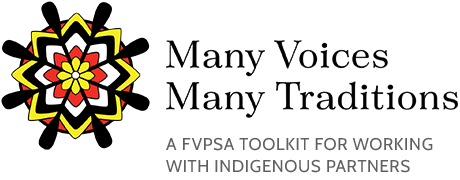How did domestic violence advocacy begin in Indian Country?
In Indigenous Nations across Indian Country and Alaska, long before the Violence Against Women Act and Tribal Coalitions Grant Program, Indigenous (Native) women were organizing to meet the needs of victims/survivors of domestic and sexual violence by opening up their homes to those fleeing from violence. Around kitchen tables and over a cup of coffee women talked about how to protect their mothers, aunties, sisters, and daughters. In Alaska, Lenora Hootch, executive director of the Yup’ik Women’s Tribal Coalition and former founding executive director of the Emmonak Women’s Shelter — one of the first women’s shelters located in Alaska, remembers her sister fleeing to the home of an elderly couple for safety. At the time, Lenora and her family did not know where she had fled, but they knew that her sister’s place of refuge had to be kept a secret if her sister was to remain safe. It is this kind of urgent grass roots, often unfunded, purely from the heart organizing that helped to shape the future of the formalized, collaborative response to violence against Native women and to create what is now the Office on Violence Against Women’s Tribal Coalitions Program.
How and when did Tribal Coalitions come into being?
Signed into law by President Clinton, the Tribal Domestic Violence and Sexual Assault Coalitions Program (Tribal Coalitions Program) was first authorized by Violence Against Women Act of 2000 (VAWA 2000) and is codified at 34 U.S.C § 10441(d) and 34 U.S.C. § 12511(d). The Violence Against Women Reauthorization Act of 2013 (VAWA 2013) changed the program from a discretionary program to a mixed formula and discretionary program, with each recognized coalition receiving an equal amount of available funds, and organizations that propose to incorporate and operate new tribal coalitions eligible to apply for discretionary funding. The Tribal Coalitions Program is funded through statutory set-asides from the STOP Violence Against Women Formula Program (34 U.S.C. § 10446(b)(4)) and the Improving Criminal Justice Responses to Sexual Assault, Domestic Violence, Dating Violence, and Stalking Grant Program (34 U.S.C. §10461(f)). The Tribal Coalitions Program also includes a statutory set-aside from the Sexual Assault Services Program (SASP), specifically for tribal sexual assault coalitions (34 U.S.C. § 12511(d)(3)(A)).1
What does the Tribal Domestic Violence and Sexual Assault Coalitions Programs support?
The program supports the development and operations of nonprofit, nongovernmental tribal domestic violence and sexual assault coalitions. Tribal coalitions provide education, support, training, and technical assistance to member Indian service providers and tribes to enhance their response to victims of domestic violence, dating violence, sexual assault, stalking, and sex trafficking.
What is the role of the Tribal Coalitions?
Tribal Coalitions are culturally (Indigenous) specific, subject matter experts who operate at the grassroots level advocating for the needs of Native communities and striving to offer the best services possible to support tribal service providers who directly serve victims and survivors of domestic and sexual violence. Collectively, the Tribal Coalition leadership has over 150 years of experience in nonprofit Tribal Coalition management and domestic and sexual violence victim services, training, technical assistance, outreach and education, and policy development.
How many Tribal Coalitions are there currently?
There are 20 distinct tribal coalitions currently operating in Indian Country and Alaska that serve tribal communities within their individual service areas.
What is the service area for a Tribal Coalition?
The service area of a tribal coalition is determined by the coalition based upon the tribal governments the tribal coalition seeks to serve, irrespective of state borders and boundaries. Some tribal coalitions are organized to serve regions which extend across multiple states or sections of states. Some tribal coalitions serve only the tribes in one particular state, and one tribal coalition serves a single tribe with many villages.
How do Tribal Coalitions serve Indigenous Nations?
Tribal Coalitions recognize that the most difficult and valued work in the field of domestic and sexual violence advocacy is done at the community level by tribal programs and individuals that provide direct services to victims of domestic and sexual violence. When the tribal programs succeed, victims/survivors are being served and tribes are responding to the violence occurring in their respective communities.2
Examples of how Tribal Coalitions serve Indigenous Nations:
- Providing trainings and technical assistance for advocates and community professionals to build and strengthen the knowledge and skills needed to serve victims;
- Coordinating, assisting with and participating in community awareness and education events;
- Providing guidance on programmatic and financial reporting requirements helping state and federally funded tribal grantees to stay in compliance with funding requirements;
- Sharing research, best practices, forms and policies to help build program capacity;
- Collectively addressing all forms of oppression and helping to create safe space for Indigenous voices to be heard where decisions are being made;
- Helping to facilitate relationships with tribal and non-tribal allies, agencies, and organizations;
- Facilitating discussions on issues and challenges relating to safety, justice, and healing;
- Encouraging self-care as related to vicarious trauma and for the extraordinary commitment to the work of ending violence against Native women.
How do Tribal Coalitions differ from State Domestic Violence Coalitions?
While the work of the tribal coalitions may differ from state to state, region or tribe, their purpose is clearly defined in the Violence Against Women Act federal statute. Tribal coalition grant funding can be used to:
- Increase the awareness of domestic violence and sexual assault against Indian women;
- Enhance the response to violence against Indian women at the Federal, State, and tribal levels;
- Identify and provide technical assistance to coalition membership and tribal communities to enhance access to essential services to Indian women victimized by domestic and sexual violence, including sex trafficking; and,
- Assist Indian tribes in developing and promoting State, local and tribal legislation and policies that enhance best practices for responding to violent crimes against Indian women, including the crimes of domestic violence, sexual assault, sex trafficking, and stalking.
